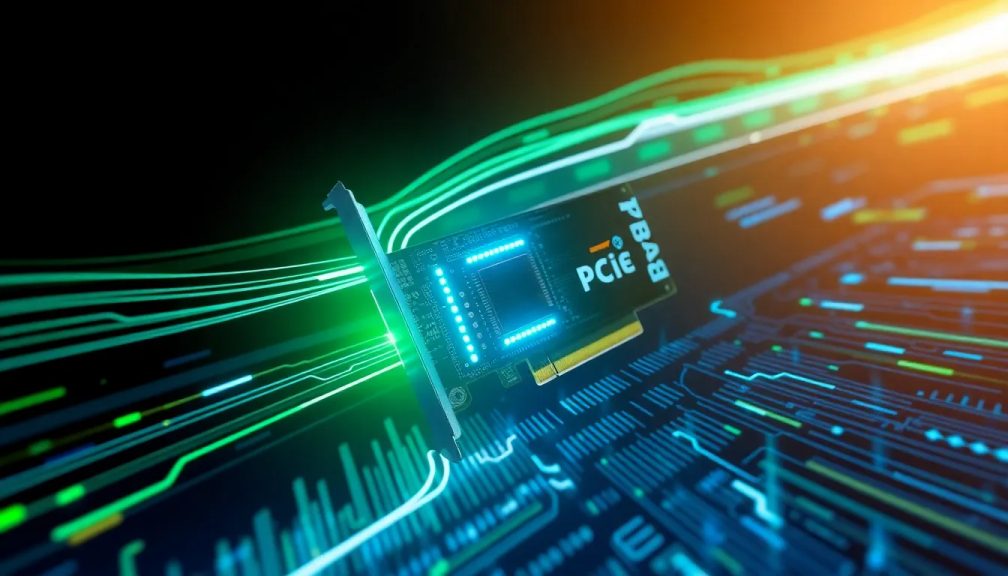PCIe 8.0 version 0.3 features 256 GT/s and 1 TB/s bandwidth

The evolution of technology is relentless, especially in the realm of computer hardware. One of the most critical components in any modern PC is the motherboard, which includes various connectors that facilitate communication between different parts of the system. Among these connectors, the PCI Express (PCIe) slots stand out due to their essential role in connecting graphics processing units (GPUs), M.2 solid-state drives (SSDs), and other expansion cards like sound cards and network interfaces. As we advance through different generations of PCIe, we see significant improvements in transfer speeds and bandwidth. Currently, PCIe 5.0 is the standard in use, but the PCI Special Interest Group (PCI-SIG) has made strides in the future with the recent approval of the PCIe 8.0 draft version 0.3.
PCI Express has replaced older standards like PCI, PCO-X, and AGP, particularly in graphics cards, delivering enhanced speed and bandwidth. The first iteration, PCIe 1.0, debuted in 2003, marking its presence in the tech world for over 20 years. Initially, it offered a transfer speed of 2.5 GT/s and a bandwidth of 8 GB/s in x16 configuration. Subsequent versions, like PCIe 2.0 and PCIe 3.0, doubled these figures, with the latter achieving 8 GT/s and 32 GB/s for x16. With each evolution, PCIe has continued to adapt to the increasing demands of modern computing.
- PCIe 8.0 is in motion with version 0.3 showcasing its specifications
- PCI-SIG continues its tradition of doubling speed and bandwidth with each new PCIe generation
- Understanding PCIe technology and its impact on performance
- What is a PCIe SSD and how does it differ from traditional SSDs?
- Determining PCIe compatibility for your PC
PCIe 8.0 is in motion with version 0.3 showcasing its specifications
With the introduction of PCIe 4.0, these numbers doubled again, achieving 16 GT/s and an astounding 64 GB/s of bandwidth. Despite the advancements, many systems still rely on PCIe 3.0 and 4.0 for their GPUs and SSDs. PCIe 5.0, launched in 2019, has yet to be widely adopted, primarily due to the high costs associated with compatible hardware. Moreover, the announcement of PCIe 6.0 in 2022 brought 64 GT/s and 256 GB/s to the table, effectively doubling the previous performance metrics. Not to be outdone, PCIe 7.0 emerged a few months ago, pushing the envelope even further with 128 GT/s and 512 GB/s.
Now, PCI-SIG has unveiled the PCIe 8.0 specification in draft version 0.3, marking a critical milestone in its development. This upcoming version promises to be a worthy successor to PCIe 7.0, continuing the trend of doubling performance metrics. The anticipated specifications for PCIe 8.0 include transfer speeds reaching up to 256 GT/s and bidirectional bandwidth of up to 1 TB/s on x16 lanes.
PCI-SIG continues its tradition of doubling speed and bandwidth with each new PCIe generation
In addition to the promise of improved speed and bandwidth compared to PCIe 7.0, PCI-SIG has set ambitious goals for latency and Forward Error Correction (FEC). A crucial aspect of PCIe 8.0 is its backward compatibility with previous versions, ensuring that users can still utilize older components without needing to invest in the latest technology.
Another notable update in PCIe 8.0 includes enhancements to the connection protocol aimed at increasing bandwidth capacity. In line with contemporary energy efficiency goals, PCI-SIG is also exploring methods to reduce power consumption significantly. With the recent rollout of PCIe 7.0, PCIe 8.0 is expected to be finalized and ready for deployment by 2028.
Understanding PCIe technology and its impact on performance
PCIe technology serves as the backbone of modern computing, allowing for efficient data transfer between the CPU, GPU, and other peripherals. The architecture of PCIe consists of lanes, where each lane can carry data simultaneously in both directions. This parallel data transmission is what enables PCIe to achieve high throughput rates.
To better understand PCIe's role, consider the following key points:
- Scalability: PCIe allows for multiple lanes (x1, x4, x8, x16), making it suitable for various applications.
- Bandwidth: Each new version typically doubles the bandwidth, accommodating faster devices and applications.
- Compatibility: New versions retain compatibility with older hardware, enabling a gradual upgrade path for users.
- Low Latency: PCIe technology is designed for minimal latency, enhancing performance in high-demand scenarios.
What is a PCIe SSD and how does it differ from traditional SSDs?
Solid State Drives (SSDs) have revolutionized data storage, and PCIe SSDs are at the forefront of this transformation. Unlike traditional SATA SSDs that utilize the older interface, PCIe SSDs connect directly to the motherboard, leveraging the high-speed lanes offered by the PCIe standard.
Key differences between PCIe SSDs and traditional SSDs include:
- Speed: PCIe SSDs provide significantly faster read and write speeds compared to SATA SSDs.
- Latency: Lower latency in PCIe drives results in quicker access to data.
- Form Factor: Many PCIe SSDs come in the M.2 form factor, which is smaller and more efficient than standard SSDs.
Determining PCIe compatibility for your PC
Knowing which version of PCIe your PC supports is crucial for optimizing performance and ensuring compatibility with new hardware. Here are a few steps to check your system's PCIe support:
- Identify your motherboard model and check the manufacturer's specifications.
- Use tools like CPU-Z or Speccy to assess the details of your PCIe slots.
- Review the specifications of your current components to see which PCIe version they utilize.
This knowledge will empower you to make informed decisions when upgrading your system or purchasing new hardware.
For a deeper dive into PCIe technology, you can also check this informative video on PCIe developments:




Leave a Reply